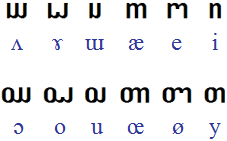This is another easily written, phonetically constructed script from my Phonological Cypher series. It runs in two channels, with vowels above and consonants below, in a rather inefficient cursive style. The name comes from the Thai word for “swan”.
Consonants
This is a table of the consonants in their phrase-initial or mid-cluster form. Each column holds a particular manner and, except for the last two rows, each row a particular location. The second last row has modified glyphs derived from the main series, and the last row has laterals and the null final. Vowels (if any) will hover at the upper right of their consonant; they will also attach to the head of the next consonant. The null final is really just a pause marker (see below), and open-syllable vowels will attach to it if they precede a pause in the phoneme stream. Thus the path of reading follows a zigzag pattern, echoed in the body of the consonant glyphs. In practice, the up-down squiggles can be written much closer than is shown here.
Vowels
The vowel set is the same as that of Monto, dividing the space into six. Rounding is shown with an oval attached to the left. Vowels attach to the head of the following consonant, replacing the simple blobbed curl shown in the table above. Diphthongs are written with a gap between.
Other marks
An affricate, palatizer and/or ejective mark can be added where necessary to provide extra consonantal phonemes; there are four examples shown. There are also two pause markers, and vowels may attach to the head of either one, whenever the next consonant in the phoneme stream is delayed.
Example
This is the beginning of Shakespeare’s sonnet 18 again (transliteration only), for comparison with versions of SIGIL etc.

Shall I compare thee to a summerís day



